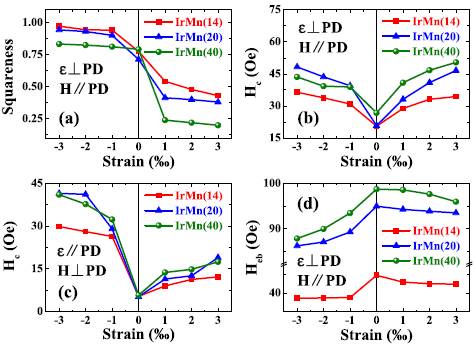We have fabricated flexible exchange biased heterostructures with magnetostrictive Fe81Ga19 alloy as the ferromagnetic layer and Ir20Mn80 as the antiferromagnetic layer on polyethylene terephthalate substrates. The mechanical strain can modify both the strength and the orientation of the uniaxial anisotropy, giving rise to the switching between the easy and hard magnetization directions. Different from the previously reported works on rigid exchange biased systems, a drastic decrease in exchange bias field was observed under a compressive strain with magnetic field parallel to the pinning direction, but only a slightly decrease was shown under a tensile strain. Based on a Stoner-Wohlfarth model calculation, we suggested that the distributions of both ferromagnetic and antiferromagnetic anisotropies be the key to induce the mechanically tunable exchange bias.
The authors acknowledge the financial support from the National Natural Foundation of China (11174302), State Key Project of Fundamental Research of China (2012CB933004), Zhejiang and Ningbo Natural Science Foundations, and Chinese Academy of Sciences (CAS), and Ningbo Science and Technology Innovation Team (2011B82004).

The applied strain dependence of (a) loop squareness, (b) Hc, and (d) Heb for H parallel and e perpendicular to the PD, and (d) Hc for H perpendicular and e parallel to the PD in FeGa(10 nm)/IrMn(tIrMn) bilayers with different tIrMn.